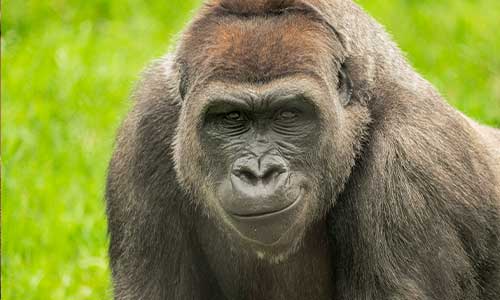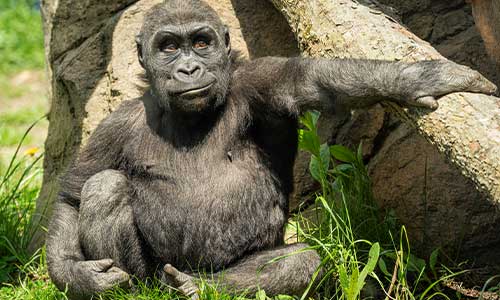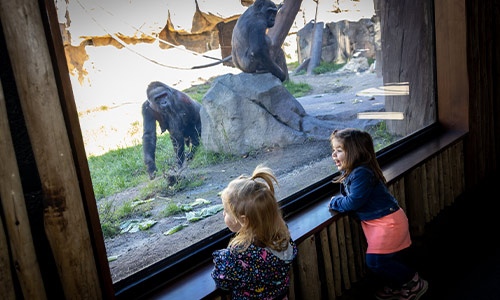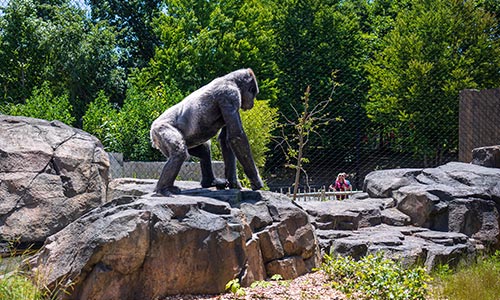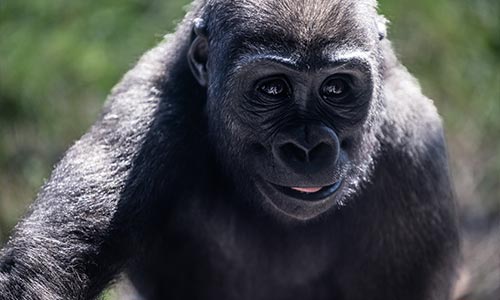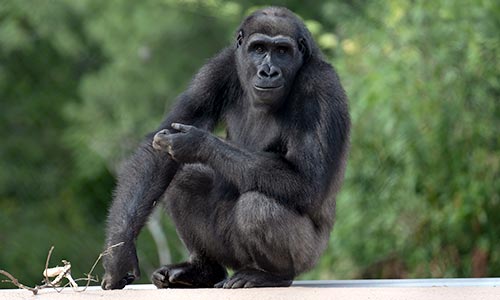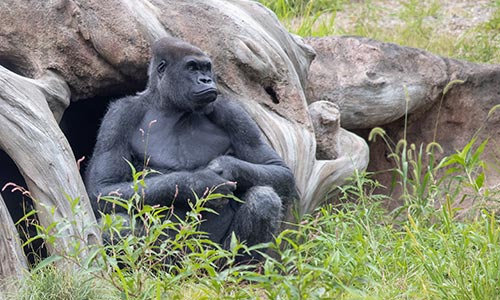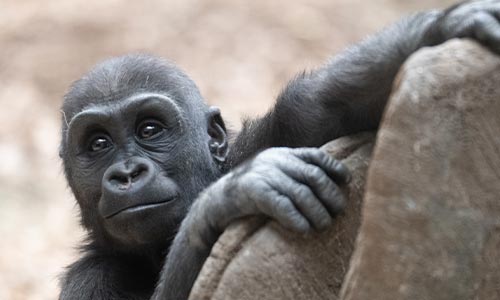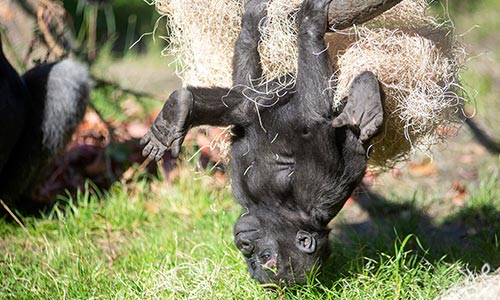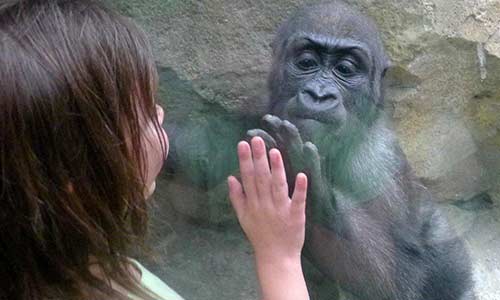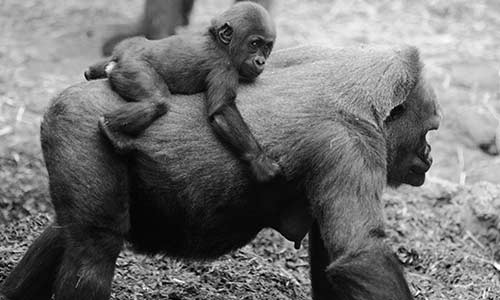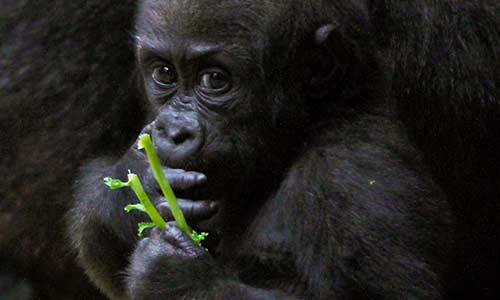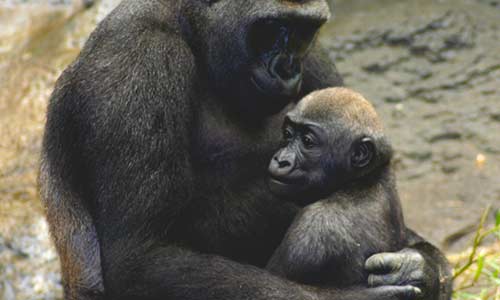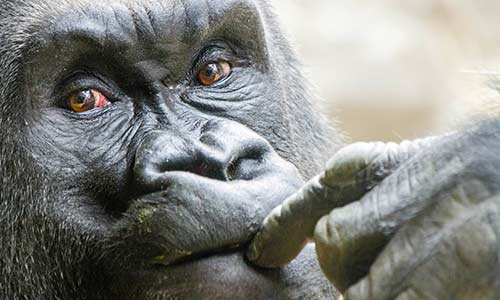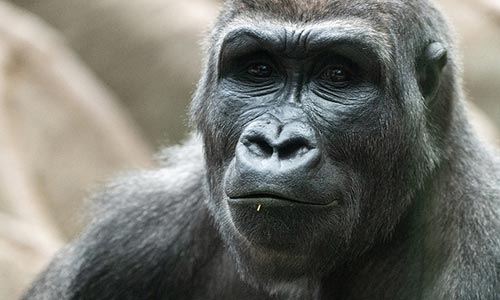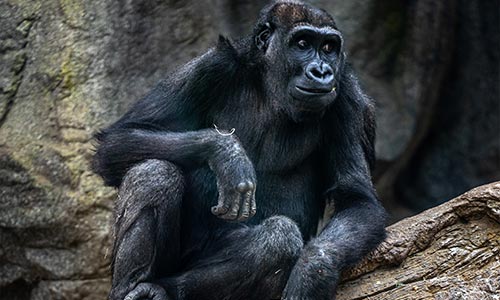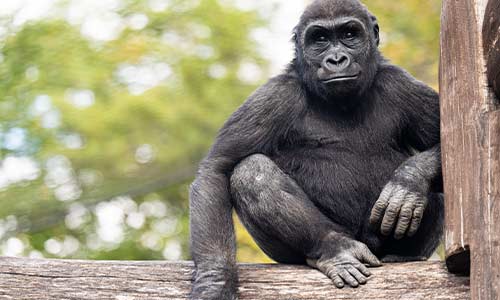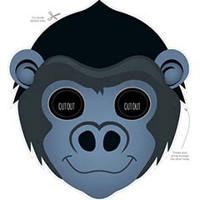Western Lowland Gorilla
Gorilla gorilla gorilla
Tune into our live cams!
Cam hours: Daily, 9am - 3:45pm, EST
You can control cams by clicking the ![]() button in the lower right corner of the viewing window.
button in the lower right corner of the viewing window.
About the Western Lowland Gorilla
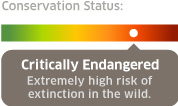
Geographic Range:
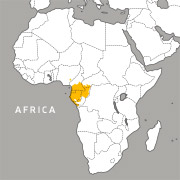
Class: Mammalia
Order: Primates
Family: Hominidae
Genus: Gorilla
Species: gorilla
Subspecies: gorilla
Gorillas are the world’s largest living primates. Male western lowland gorillas can grow to 5.5-feet tall and weigh up to 450 pounds. Females can grow to 4.5-feet tall and weigh up to 250 pounds. Western lowland gorillas live in groups, or “bands” in or near African forests. The alpha male leads the band and those who challenge him are apt to be cowed by impressive shows of physical power—he may throw things, make aggressive charges, pound his huge chest while barking out powerful hoots, or unleash a frightening roar.
Committed to Conservation
Gorilla numbers in the wild are declining at a rapid rate. Ebola virus and the commercial bush meat trade, along with extreme habitat loss and poaching are the main causes behind gorilla deaths. As a result, the western lowland gorilla’s numbers have declined by more than 60% over the last 20 to 25 years. According to the World Wildlife Federation, even if all of the threats to this species were removed, scientists calculate that the population would require some 75 years to recover. To that end, Zoo New England has been an active participant in gorilla conservation through the following programs and initiatives:
SAFE: Saving Animals From Extinction & Cross-River Gorilla Conservation
We're proud to support the Association of Zoos and Aquariums' SAFE initiative. This program brings together the expertise and resources of AZA-accredited zoos, aquariums, and conservation organizations to protect endangered species and their habitats.
Through this program, Zoo New England partners with the Wildlife Conservation Society to help strengthen the management and enforcement of protections for Cross-River gorillas within Nigeria's Afi Mountain Wildlife Sanctuary.
Electronic gadgets like cell phones, ipods and tables contain coltan, a mineral extracted from the forests of Africa. Mining for coltan destroys the natural habitat of gorillas and many other species, pushing these animals closer to extinction. Zoo New England has teamed up with Eco-Cell, a company that partners with zoos across the country, to collect your recycled cell phones and refurbish them for reuse. This reduces the need for more coltan, leads to less mining and destruction of habitat, and helps the gorillas!
Zoo New England participates in the Western lowland gorilla Species Survival Plan. By sharing research and knowledge, participating institutions work together to establish guidelines that best ensure the health of captive populations, and with success, the survival of endangered species.
Gorilla Facts
Appearance:
The western lowland gorilla has dark brown to black fur and black skin. Facial features include a prominent brow ridge, small eyes and ears, large nostrils and short muzzles. Gorillas have broad, strong teeth and large jaw muscles. Coarse black to brown hair covers the body except for the face, hands and feet. The hair of mature males from shoulders to rump grows gray with age giving them the nickname "silverback." Males have an enlarged sagittal crest, which is a bone ridge on the top of the cranium.
Size:
Height: Males up to 5.5 feet tall; females up to 4.5 feet
Weight: Males up to 450 pounds; females up to 250 pounds
Diet:
Gorillas eat more than 200 types of plants including fruits, flowers, shoots, bulbs, bark and leaves, as well as invertebrates (like ants and termites).
Reproduction:
Gorillas don't have a breeding season. The female's estrus cycle occurs every 30-33 days. Usually only the dominant silverback male gets to breed, but sometimes a troupe is led by multiple younger males (called “black backs” due to the lack of silver coloration on their back).
Gestation:
Lasting 250 to 285 days, gestation usually results in one offspring (twins are rare). Young are weaned after 36 to 48 months. Males reach sexual maturity in 6-11 years and females in 6-8 years. When mature, both genders leave their group to find another to prevent inbreeding.
Behavior:
Western lowland gorilla groups generally consist of one dominant silverback male and multiple females and their offspring. At times gorilla groups may consist of multiple males with more than one silverback or multiple younger males. Their group size in the wild generally averages eight individuals, but groups as large as 20 have been recorded. The silverback male responds to challenges made against him by an intimidating display. He may make aggressive charges, stand upright and pound his huge chest while barking out powerful hoots or even throw things.
Due to their dependence on seasonal fruit, western lowland gorillas have the largest home range of the four gorilla subspecies. They spend most of their time on the ground, although the young may spend some time in the lower canopy while foraging. Gorillas build nests for both day and night. Night nests consist of branches and leaves; day nests provide a cushion on the ground.
Habitat/Range:
Tropical forests, swamp forests, clearings and forest edges in the African countries of Cameroon, Gabon, Central African Republic, Republic of Congo, Equatorial Guinea, Cabinda (Angola), and possibly Democratic Republic of Congo although it is likely they are extinct there.
Median Life Expectancy:
Males: 31.7 years
Females: 38.3 years
Threats in the wild:
Gorilla numbers in the wild are declining at a rapid rate. Ebola virus (hemorrhagic fever) and the commercial bush meat trade, along with habitat loss and poaching are the main causes behind gorilla deaths. The loss of their forest habitat is a twofold threat since habitat loss also brings hungry people who hunt gorillas for bushmeat.
You Can Help!
- Avoid palm oil: The presence of palm oil in everyday products — from the food we eat to the products we use for skincare — is widespread and is causing significant habitat loss and population declines. As consumers, one of the first steps we can take is to refuse to buy products that contain palm oil, thereby reducing the continued demand. Additionally, pressure must be put on companies to adopt sustainable and ecological-friendly practices for palm oil cultivation.
- Promote sustainable forestry: Human population growth does not mean that the survival of great apes is automatically threatened. Sustainable forestry can lead to both the protection of great apes and further economic development. A good starting point for promoting sustainable development can be when you commit to purchasing paper and wood products that have been certified as sustainable by a reputable entity. You can learn more about the different types of eco-labeling.
- Recycle your cell phone: Many of us have old phones lying around our house that we don’t even use. These phones contain coltan, which is a material mined from the gorilla's natural habitat. When recycled, old electronics and chargers can have a major impact on the lives of gorillas. Learn more about our electronic recycling program.
Gorillas can explore Gorilla Grove when it’s sunny and at least 55 degrees. On rainy days, the temperature must be at least 60 degrees. If it's cooler or wet, you’ll find the troop staying warm inside the Tropical Forest.
You Can Find This Animal in the Tropical Forest , Gorilla Grove
Gorilla Forage Feed & Chat
Join us daily at 2:00 p.m. for a Gorilla Forage Feed & Chat!
You can make a difference
Just for kids!
Download your own gorilla mask, coloring page and learn more about our gorilla family in our Kids' Corner!
Zoodopt a gorilla
Zoodopts support the care and feeding of our animals, and with each purchase, we'll bring a little of the Zoo to you! Zoodopt today!
You May Also Like
At Franklin Park Zoo:
At Stone Zoo:

